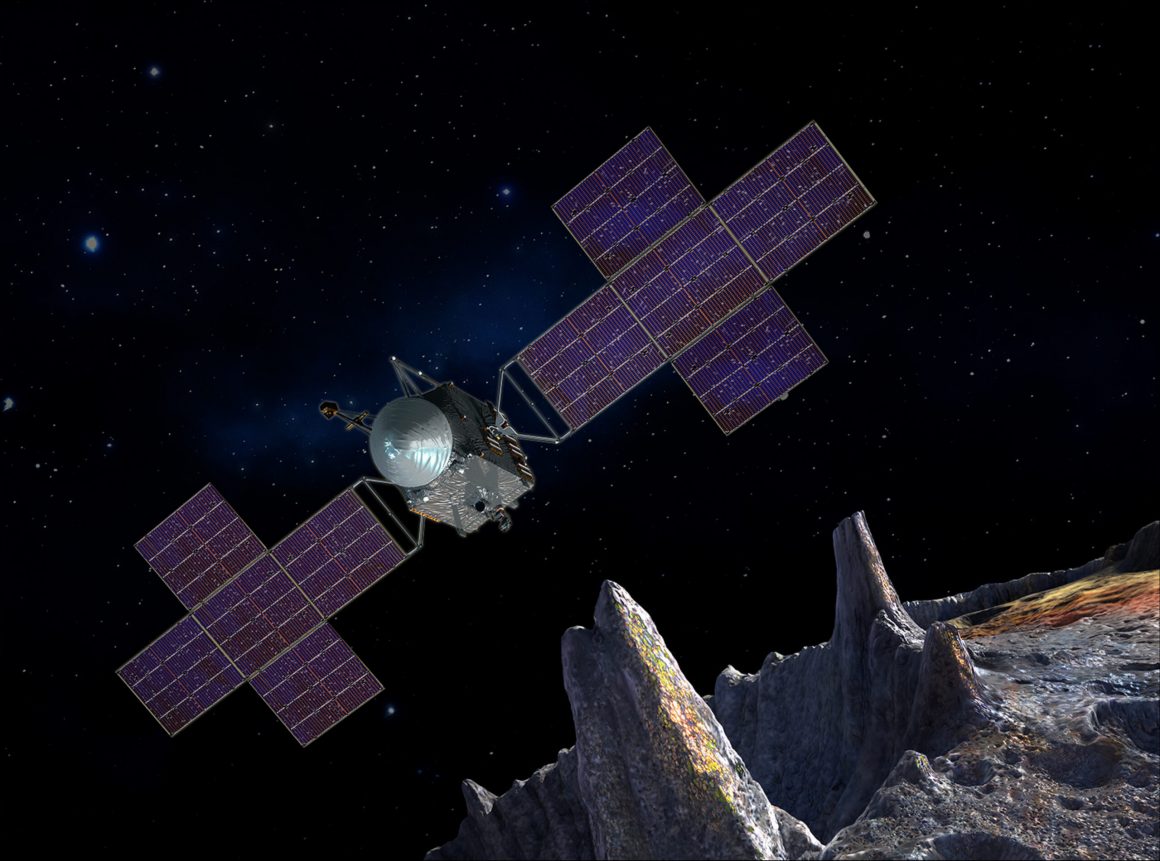
NASA’s Psyche mission: Space lasers and ion thrusters coming to an asteroid near you
By Zal Dholoo, December 4 2023—
On Oct. 13, a Falcon Heavy orbital launch vehicle carrying the Psyche spacecraft was launched from Kennedy Space Centre to send its 2,608 kg payload on a six-year journey to the main asteroid belt, which sits between Mars and Jupiter. Aboard this spacecraft are a number of interesting new technologies making their debut, such as ion thrusters and laser optical communications. The spacecraft’s destination, 16 Psyche, is an asteroid that is thought to be mostly composed of metal, and is the largest known asteroid of this kind; it was even once thought to be a planet. When Psyche reaches the asteroid it will mark the first time that a metallic asteroid has been imaged with such fidelity.
When the mission to the asteroid was originally proposed in 2015, 16 Psyche was thought to be a nascent planet that had been stripped of all but its metallic core. Since then, through radar observation and other techniques, it is found unlikely that the asteroid is pure metal. It is estimated instead that the asteroid is between 30 and 60 per cent metal, made up of mostly iron-silicate rock.
The asteroid 16 Psyche got its name from a convention of the 1800s where astral objects were referred to with icons rather than names. 16 Psyche was originally referred to with a butterfly wing with a star, the Ancient Greek symbol for the soul. Later, when names for asteroids were formalized, the asteroid was named after the goddess of the soul, Psyche, and got its prefix because it was the sixteenth such astral body discovered.
The optical communications suite aboard Psyche is meant to demonstrate a new way of communicating with spacecraft far away from Earth. Current communications with spacecraft use the Deep Space Network, which maintains radio contact with all active spacecraft. Using radio waves means that NASA has to increase the amount of satellite dishes equally at three sites on the Earth to facilitate communication with new spacecraft, a costly endeavour. Instead, using optical communication has the potential to be able to both increase the data transfer rate, and decrease the physical footprint of the communication network. Each satellite dish on Earth is 70 meters across, and there are 14 at three sites around the world. The Deep Space Communications Network will be able to communicate with an optical telescope on Earth, and relay information through it, theoretically being able to do the job of the satellite dishes with a smaller footprint.
The thrusters aboard the Psyche spacecraft are the first of their kind to be used beyond the Earth’s gravitational sphere of influence. Unlike traditional rocket motors, which use heavy propellants to generate a chemical reaction which exhausts mass to push the spacecraft forward, Psyche’s Hall effect thrusters use a modest amount of xenon gas which is accelerated via an electromagnetic field. This means that the Hall effect thrusters aboard Psyche can operate for far longer and with much less propellant, meaning more scientific instrumentation can be brought aboard. This comes at the cost of the amount of thrust that can be produced. Psyche’s thrusters can only produce about 240 millinewtons of thrust. This is roughly equal to the amount of force that is generated by the Earth’s gravity acting on five sheets of paper, but its high endurance means that the spacecraft will steadily accelerate in order to reach its destination.
Psyche was initially intended to be launched in summer 2022, in order to take advantage of an opportunity where Mars was available for a gravity assist. A lack of personnel assigned to the project meant that it had to be delayed, and as such instead of reaching 16 Psyche in 2026, the spacecraft will now begin its 21-month data collection in 2029.
Though the development was fraught with delays, this is a historic mission meant to explore the far reaches of the galaxy, to understand the nature of asteroids, and to test new ways of communicating and travelling in space.
